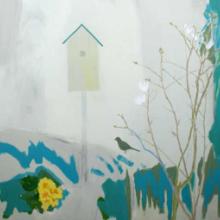
Janet Melrose – whose exhibition 'Still Life' shows in the Union Gallery this month – was trained at Edinburgh College of Art, and now lives in Perthshire on the banks of the Earn. In picturing her surroundings there, she explores the delicate threads between human experience and Nature; the present and remembered past; imagination, so-called reality and possible alternatives.
If any of that sounds either airy or grandiose, don't be put off. Her works are studiedly simple and attractive.
Melrose typically records intense interstices in time and space: short-lived, keenly felt and observed stillnesses in which – for example – her eye is met and held by that of a bird and there occurs some curious, mutual recognition, a glint of shared understanding.
She looks also for links between apparently disconnected forms, and creates shared contexts of unconventional colour, positioning or framing which suggest that the world could be quite differently ordered to the way its surface details may suggest.
In exploring such intuitions, she treads the finest of lines between literal representations and more symbolic depictions, presences and absences. There is a great deal of space in her paintings, but what at first glance may appear unfilled or incomplete is always meaningful – the result of carefully considered reduction.
'I want my work to contain only what is necessary,' she writes. 'I want the colour and marks made to be carefully placed on the paper or canvas and to feel as if everything is hanging in the balance.'
[img_assist|nid=1752|title=|desc=|link=node|align=right|width=200|height=200]Paradoxically, then, that sense of calm spaciousness her paintings foster (often in dreamy shades of blue and green) can be read quite differently. Blue Yonder features a figure with a dog standing at the end of a jetty. We see that they are watching a boat, but we cannot tell who is on the boat or whether it's arriving or departing. Our attention switches to the gulf between and around them, the uncertainty of union or parting. At first apparently still, the painting resolves into one about movement and continuity – literal and metaphorical.
[img_assist|nid=1750|title=|desc=|link=node|align=right|width=152|height=200]Whenever she chooses to be, Melrose is a sensitive and accurate naturalist. Birds on the Damson, for example, combines the stylised simplicity of Japanese art with beautifully evocative realism. However, the world which interests her is always one in motion. Her stilled birds are the birds you see from the corner of your eye, or fleetingly, just before flight; her foxes – returning look for look – are the kind you might watch pause for a brief moment before they dissolve back into the shadow of cover.
More clearly, solidly realised is the recurring figure of a pet dog – a beautifully rendered guide who seems to stand halfway between the artist and an evanescent reality at the edge of vision. He mediates between humanity and the wild, as in Dog and Blossom (detail below), or between physical existence and the supernatural as in Pointer.
Simple, certainly, and yet delightfully filled with mysteries, Melrose's works consistently repay close attention. Stand quietly for 10 minutes, be patient, and wait for their secrets to emerge. AM
'A Still Life' will show at the Union Gallery, 45 Broughton Street, until 6 June.
[img_assist|nid=1753|title=|desc=|link=node|align=middle|width=640|height=536]